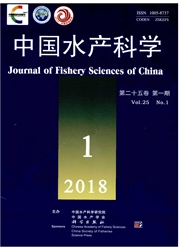

 中文摘要:
中文摘要:
采用cDNA末端快速扩增技术(Rapid Amplification of cDNA Ends,RACE)克隆获得了刀鲚(Coilia nasus)水通道蛋白1(AQP1)全长cDNA序列。其碱基序列全长为1299 bp,5′端、3′端非翻译区(untranslated regions,UTR)长度分别为107 bp和458 bp,开放阅读框(open reading frame,ORF)长度为777 bp,共编码258个氨基酸。理论等电点是6.13,蛋白分子量为27.1 kD。结构分析表明,刀鲚AQP1具有水通道蛋白家族典型结构特征,包括6个跨膜结构域,2个天冬酰胺-脯氨酸-丙氨酸(NPA)特征序列,同时还具有AQP1抑制剂含汞化合物的半胱氨酸结合位点。序列同源性及系统进化分析表明,其与同属鲱形目的大西洋鲱的同源性最高(93%),并且与其聚为一支。实时荧光定量分析结果表明,刀鲚AQP1基因在多种组织中有表达,包括脑、鳃、肝、前肠、后肠、中肾、肌肉。高盐度作用后,AQP1在渗透调节作用关键组织鳃、中肾、肠中的表达水平有显著差异(P〈0.05),体现了AQP1在刀鲚渗透调节中的重要作用。本研究结果可为今后进一步探讨刀鲚渗透调节相关基因的调控机制提供理论参考。
 英文摘要:
英文摘要:
The Coilia nasus is a commercially important anadromous species distributed mainly in the Yangtze River of China and in coastal waters of China, Korea and Japan. The species is popularly known locally as one of the three most delicious fishes in the Yangtze River, along with the obscure pufferfish Takifugu fasciatus and Reeves shad Tenualosa reevesii; additionally, Coilia nasus is the main source of income for many Yangtze River fishermen. Coilia nasus migrates to sea for growth and so experiences a wide range of salinities, making osmo- regulation especially important for the species during this migration. The protein aquaporin-1 (AQP1), a member of the aquaporin family of integral membrane proteins, functions in transporting water as well as ammonia, urea and glycerin. Accordingly, it is important for hypertonic and hypotonic regulation and maintaining osmotic homeostasis in an organism. To investigate the osmoregulatory role of AQP 1 in Coilia nasus, we used rapid amplification of complementary DNA (cDNA) ends (RACE method) to clone, for the first time, aquaporin-1 from this species. The full-length cDNA covered 1 299 base pairs (bp) with a 777 bp open reading-frame (ORF) within the 5' untranslated region (UTR) of 107 bp and the 3'UTR of 458 bp. The ORF encoded 258 amino acids, with a calculated molecular mass of 27.1 kDa, and theoretical isoelectric point of pH 6.13. The results show that AQP1 of Coilia nasus possesses typical conserved domains of the AQP family, including six transmembrane helices and two NPA (Asn-Pro-Ala) motifs, and one binding site for mercury (II) chloride (HgCl2), which is an AQP1 inhibitor. Next, we analyzed the homology and phylogenetic systematics of the AQP1 sequence from Coilia nasus. The highest homology and similarity (reaching 93%) occurred between the AQP1 of Coilia nasus and the AQP1 of Atlantic herring Clupea harengus. The AQP1 of Coilia nasus displayed an evolutionary relationship the furthest from AQP1 of mammals. We performed rea
 同期刊论文项目
同期刊论文项目
 同项目期刊论文
同项目期刊论文
 期刊信息
期刊信息
